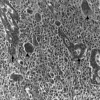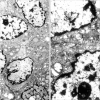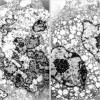A case of osteoclast-like giant cell tumor of the pancreas with ductal adenocarcinoma: histopathological, immunohistochemical, ultrastructural and molecular biological studies
- PMID: 15953882
- PMCID: PMC2782216
- DOI: 10.3346/jkms.2005.20.3.516
A case of osteoclast-like giant cell tumor of the pancreas with ductal adenocarcinoma: histopathological, immunohistochemical, ultrastructural and molecular biological studies
Abstract
Osteoclast-like giant cell tumor of the pancreas is a very rare neoplasm, of which the histiogenesis remains controversial. A 63-yr-old woman was hospitalized for evaluation of epigastric pain. An abdominal computerized tomography revealed the presence of a large cystic mass, arising from the tail of pancreas. A distal pancreatectomy with splenectomy was performed. Histologically, the tumor was composed of mononuclear stromal cells intermingled with osteclast-like giant cells. In addition, there was a small area of moderately to well differentiated ductal adenocarcinoma. The final pathologic diagnosis was osteoclast-like giant cell tumor of the pancreas with ductal adenocarcinoma. Here, we describe the histopathological, immunohistochemical, ultrastructural and molecular biological findings of this tumor with review of the literature pertaining to this condition.
Figures





Similar articles
-
An unusual epithelial pleomorphic giant cell tumour of the pancreas with osteoclast-type cells.J Clin Pathol. 1994 Apr;47(4):372-4. doi: 10.1136/jcp.47.4.372. J Clin Pathol. 1994. PMID: 7517956 Free PMC article.
-
Osteoclast-like giant cell tumor of the pancreas.Int J Clin Oncol. 2002 Dec;7(6):376-80. doi: 10.1007/s101470200059. Int J Clin Oncol. 2002. PMID: 12494256 Review.
-
Undifferentiated carcinoma with osteoclast-like giant cells of the pancreas and periampullary region.Cancer. 1998 Apr 1;82(7):1279-87. doi: 10.1002/(sici)1097-0142(19980401)82:7<1279::aid-cncr10>3.0.co;2-3. Cancer. 1998. PMID: 9529019
-
Undifferentiated carcinoma of the pancreas with osteoclast-like giant cells: a rare case report and review of the literature.Int J Clin Exp Pathol. 2015 Sep 1;8(9):11785-91. eCollection 2015. Int J Clin Exp Pathol. 2015. PMID: 26617927 Free PMC article. Review.
-
Undifferentiated carcinoma with osteoclast-like giant cell tumor of the pancreas: a discussion of rare entity in comparison with pleomorphic giant cell tumor of the pancreas.Indian J Pathol Microbiol. 2010 Oct-Dec;53(4):867-8. doi: 10.4103/0377-4929.72016. Indian J Pathol Microbiol. 2010. PMID: 21045455 No abstract available.
Cited by
-
A case of atypical gastric carcinoma with osteoclast like giant cells.Mcgill J Med. 2008 Jul;11(2):152-5. Mcgill J Med. 2008. PMID: 19148314 Free PMC article.
-
FNA diagnosis of osteoclast-like giant cell tumor of the pancreas.J Cytol. 2012 Oct;29(4):270-2. doi: 10.4103/0970-9371.103951. J Cytol. 2012. PMID: 23326036 Free PMC article.
-
Case of Six-Year Disease-Free Survival with Undifferentiated Carcinoma of the Pancreas.Case Rep Gastroenterol. 2016 Aug 31;10(2):472-478. doi: 10.1159/000448878. eCollection 2016 May-Aug. Case Rep Gastroenterol. 2016. PMID: 27721735 Free PMC article.
-
A case report of undifferentiated carcinoma with osteoclast-like giant cells of the pancreas and literature review.Clin J Gastroenterol. 2010 Aug;3(4):195-203. doi: 10.1007/s12328-010-0160-2. Epub 2010 Jul 9. Clin J Gastroenterol. 2010. PMID: 26190247
-
A Rare Case of Pancreatic Cancer: Undifferentiated Carcinoma of the Pancreas With Osteoclast-Like Giant Cells.Cureus. 2022 May 18;14(5):e25118. doi: 10.7759/cureus.25118. eCollection 2022 May. Cureus. 2022. PMID: 35733473 Free PMC article.
References
-
- Rosai J. Carcinoma of pancreas simulating giant cell tumor of bone: electron-microscopic evidence of its acinar cell origin. Cancer. 1968;22:333–344. - PubMed
-
- Alguacil-Garcia A, Weiland LH. The histologic spectrum, prognosis, and histogenesis of the sarcomatoid carcinoma of the pancreas. Cancer. 1977;39:1181–1189. - PubMed
-
- Lewandrowski KB, Weston L, Dickersin GR, Rattner DW, Compton CC. Giant cell tumor of the pancreas of mixed osteoclastic and pleomorphic cell type: evidence for a histogenetic relationship and mesenchymal differentiation. Hum Pathol. 1990;21:1184–1187. - PubMed
-
- Sun AP, Ohtsuki Y, Liang SB, Sonobe H, Iwata J, Furihata M, Takeuchi T, Qiu Y, Chen BK, Watanabe R, Ohmori K. Osteoclast-like giant cell tumor of the pancreas with metastases to gallbladder and lymph nodes. A case report. Pathol Res Pract. 1998;194:587–594. - PubMed
-
- Machado MA, Herman P, Montagnini AL, Jukemura J, Leite KR, Machado MC. Benign variant of osteoclast-type giant cell tumor of the pancreas: importance of the lack of epithelial differentiation. Pancreas. 2001;22:105–107. - PubMed
Publication types
MeSH terms
Substances
LinkOut - more resources
Full Text Sources
Medical

